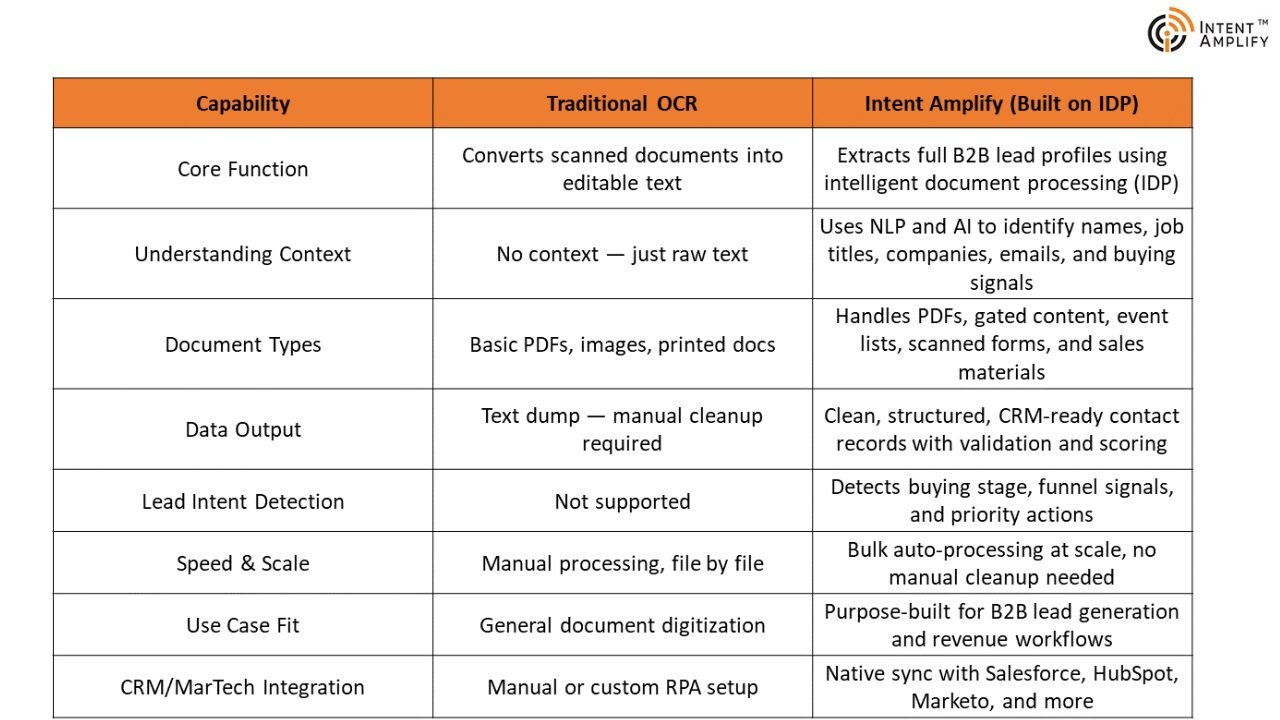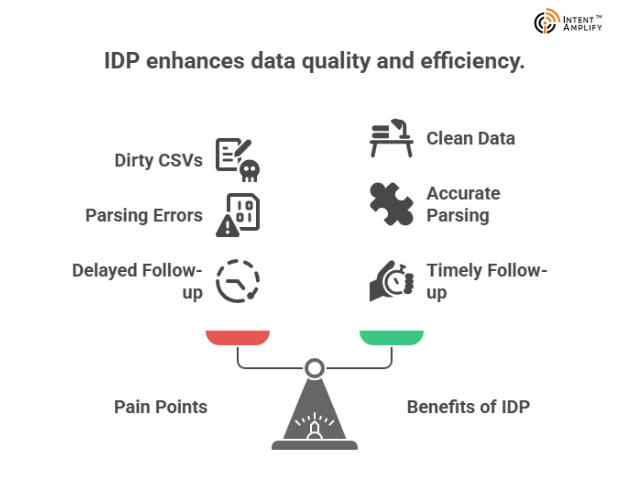
What Is Intelligent Document Processing (IDP) for B2B Lead Generation in 2025?
- Last updated on: July 14, 2025
IDP for B2B sales is not a choice.
Intelligent document processing (referred to IDP hereafter) is a step forward in the B2B sales world.
Files are ubiquitous in the B2B industry. PDF guest lists, gated eBooks, supplier guides, all filled with lead data that usually goes untapped. IDP is an AI-driven savior that scans unstructured documents, extracts contact data, verifies it, and effortlessly loads it into your CRM. No more salespeople sorting through piles of PDFs or interns manually typing up spreadsheets.
Why now? Poor data quality costs companies on average $12.9 million per year, according to Gartner. That goes beyond mere error. It encompasses the cost of correcting mistakes, mitigating delays, and responding to compliance problems.
As the number of documents grows, so do these issues. One misplaced invoice or delayed contract can cause operational delays, payments going unreceived, and threats of non-compliance.
Imagine a sales team that automatically extracts tens of thousands of qualified contacts from event PDFs, gated downloads, and partner directories and automatically triggers targeted outreach. That’s the value proposition of IDP for B2B sales: converting unstructured data into structured lead streams, quicker and more accurately than ever before.
In this article, we will:
- Understand what IDP is and how it is distinguished from simple OCR.
- Outline the manual extraction pain points that it alleviates.
- Highlight where unstructured data in real life contains gold event lists, PDFs, and emails.
- Discuss new use cases supported by recent deployments to demonstrate how teams are already deriving value.
By the end of this, you’ll know why B2B lead generation in 2025 is no longer about form fills, it’s about document‑aware data intelligence.
What Is Intelligent Document Processing (IDP)?
Intelligent Document Processing (IDP) is so much more than upgraded OCR (Optical Character Recognition).
It is an intelligent, AI-powered system that takes unstructured and semi-structured documents and turns them into refined, structured data that’s ready for action.
At its foundation, IDP blends several technologies:
- OCR (Optical Character Recognition) translates images, scans, or PDFs into editable text.
- NLP (Natural Language Processing) grasps context, recognizing names, job titles, company names, dates, or even intent.
- Machine Learning classification identifies document types and layouts without strict rules.
- Human-in-the-loop validation, alerting low-confidence fields for manual review before final approval.
- Integration through APIs or RPA, injecting cleansed data into CRMs, MAPs (Marketing Automation Platforms), or downstream processes.
As of a February 2025 industry report, 63% of Fortune 250 companies have implemented IDP solutions, with financial services being the most prominent at 71% adoption.
Advanced IDP platforms “smartly” understand a document.
Although decades-old traditional OCR tools have existed, they were never designed for contemporary B2B lead generation. Sure, they digitize documents, but they don’t comprehend them.
They can’t identify a decision-maker’s job title, verify an email address, or tell if a prospect is in the middle of the funnel or merely browsing.
That’s where IDP turns things on its head. And Intent Amplify takes it a step further by applying IDP specifically to B2B marketing and sales workflows.
The following table explains how Intent Amplify compares to legacy OCR and why abandoning the need to “read documents” and embracing the need to “activate leads” is no longer a choice.
They identify prominent entities, such as contact information, company names, and sentiment-implicating words like “evaluating” or “considering,” then scrub, remove duplicates, and validate the information against known sources before piping it into your CRM or enrichment tools.
Why Should Marketers and Sales Teams Care About IDP?
The majority of revenue teams today are laser-focused on two things: getting in front of the right buyers and doing it first. But here’s the truth: an enormous amount of precious prospect data never sees the light of day in your CRM or MAP. It’s stuck in documents nobody has time to sift through.
Consider your most recent sponsored event. You most likely had an attendee list in PDF form, perhaps a CSV export with inconsistent fields, or even scanned sign-up sheets from booth personnel. All of that has high-value contact information, but if your organization does not have the capability to rapidly extract, scrub, and act upon it, the opportunity goes unseized.
That’s where Intelligent Document Processing (IDP) comes in and why it’s a game-changer for go-to-market teams.
IDP Turns Static Documents into Sales Momentum
Intelligent Document Processing is not mere automation, it’s about revealing a secret layer of lead generation that most companies are overlooking. By transforming unstructured files into clean, structured records, IDP enables sales and marketing teams to unlock new sources of pipeline.
B2B teams can:
Pull valuable lead information from underutilized sources
IDP extracts emails, job titles, phone numbers, and company names from PDFs, scanned forms, and images that would otherwise go unused.
Engage leads quicker from atypical sources
Whether a whitepaper download or a partner asset, IDP gets you talking with new contacts quicker by auto-feeding validated information into your CRM.
Remove manual work from campaign processes
Instead of wasting hours cleaning spreadsheets or fixing form field errors, IDP automates the cleanup, freeing your team to focus on strategy and engagement.
Enrich incomplete records without toggling between tools
Many documents contain partial data. IDP fills in the blanks using NLP and integrations, giving your SDRs complete, actionable lead profiles without extra research.
Unify marketing and sales data across disconnected sources
By translating all document-captured leads into a standardized format, IDP makes your CRM, MAP, and sales tools all communicate in the same language, eliminating friction and duplication.
What This Means Throughout the GTM Function
For marketers:
IDP lets you create more dynamic, segmented campaigns. You can customize journeys based on job titles and industry keywords extracted straight from a document a person downloaded, not necessarily what they entered on a form.
For sales:
No more digging through spreadsheets or emailing IT to pull contact information. IDP integrates enriched lead information directly into your sales platforms, empowering reps to engage quickly and with higher relevance.
For revenue operations:
Rather than cleaning up busted processes, RevOps teams can spend their time scaling smarter systems. IDP makes data flows consistent, validated, and audit-ready without introducing technical debt.
Rethinking Documents as Demand Gen Assets
Here’s the attitude adjustment IDP makes: drop the notion that documents are post-click collateral. Begin to see them as the initial signal of intent. Every document your lead touches is a lead source in waiting, not merely the form they had to complete to get it.
After you start pulling out, deciphering, and responding to that latent information, you tap into a deeper level of lead insight that your competition likely isn’t even monitoring.
IDP Fixes Broken Manual Data Extraction
Catching leads is one thing; extracting and activating them is another. Here’s how IDP transforms time-wasting, error-ridden manual processes into silky, strategic pipelines full of qualified prospects:
Pain Points Without IDP
Interns or reps are manually typing out documents.
Someone scrolls PDFs or picture-heavy files, typing out names, companies, and contact information, a grueling, error-prone ceremony.
Dirty CSVs from webinars and events
Inconsistent format columns (“Email” vs. “E‑mail”) or missing fields in exported lists disrupt ingestion processes and campaign chaos ensues.
Email or company parsing errors
Tolerable format differences (john@example, .net vs .com, company.co vs company.com) may pipe data into black holes or create duplicate records.
Follow-up delayed and timing lost
Hours or days of manual cleanup are completed before follow-up, and the interest window of the prospect may already be closed.
How IDP Solves It
Automated extraction of key data fields
Names, titles, phone numbers, email addresses, all precisely extracted from PDFs, scanned documents, and attachments with near-human accuracy, in seconds.
Smart formatting and normalized output
Turns mess into method: cleans up emails, normalizes phone number formats, and combines company naming conventions into one.
Entity recognition for richer insights
IDP looks beyond contact information, detects company size, industry context, and even intent signals based on keyword patterns such as “reviewing” or “evaluation stage.”
It Imports verified records that get pushed into your CRM or marketing software automatically,
Quality control through confidence scoring
Low-confidence fields are highlighted for rapid review. IDP systems learn from corrections and get better over time without rework required from humans.
Impact Use Case: Event Form Automation
Here’s an April 2025 example: a security vendor applied IDP to read hundreds of handwritten sign-up sheets gathered at trade shows.
The Intelligent Document Processing (IDP) market is surging. As per a report from FortuneBuisnessInsights It is projected to grow from $7.9 billion in 2024 to $66.7 billion by 2032 a robust 30% CAGR fueled by business automation and compliance needs.
By streamlining these mundane, low-value tasks, your team can concentrate on what counts: strategy, interaction, and relationships. IDP does not merely solve extraction, it supercharges your entire lead-to-close process.
Where Is the Unstructured Data Hiding?
Unstructured data is scattered. Still, it is one of the most underutilized assets in B2B sales and marketing processes. It doesn’t reside in orderly rows or organized formats, instead, it’s spread throughout documents, forms, and communications that are too often forgotten once the initial project is done.
What makes unstructured data so important is that it often holds rich lead signals, company information, and decision-maker identifiers. Yet, without a system with which to interpret and engage that information, it is idle and useless.
Most marketing and sales organizations are sitting atop a lake of unused data, unaware. These sources, though ubiquitous, are seldom processed beyond their point of use and are not usually brought into any lead generation or account intelligence process.
Common Sources of Unstructured Data Marketers Overlook:
Conference Attendee Lists (PDF Format)
Following each industry event or sponsored conference, marketers tend to receive lists of attendees in PDF form. The lists may contain valuable information such as names, companies, job titles, or contact details.
Yet, the format tends to be unstandardized, inaccessible for search, and needs manual processing to be useful, causing most teams to end up saving the file or processing only half of it.
Case Study Downloads (Gated Content)
Gated assets like case studies, whitepapers, or eBooks can uncover high-intent leads. As the users download these resources, they tend to fill out forms with role information, company size, and industry.
Their downloaded content and the contextual clues within the document are seldom dug for more insight.
Partner and Vendor Directories
These lists, whether shared between alliances or procured via co-marketing efforts, are commonly disseminated as Excel spreadsheets, PDFs, or CRM-exported files. They usually have company-level attributes and decision-maker names which could inform account-based marketing campaigns, but the absence of standardized formatting keeps them from being fully utilized.
Email Attachments
Sales and marketing teams send thousands of documents to each other over email like intro decks, event invitations, contracts, and brochures. .
Attachments frequently have lead data or purchasing signals embedded in them, but they’re not often indexed or processed in a systematic fashion. This unstructured flow of intelligence is continuously underutilized because it’s impossible to squeeze value out of it at scale.
Sales Notes and Scanned Forms
Either gathered on trade show floors, site visits, or onboarding calls, paper-based forms and sales notes tend to capture unfiltered, high-intent data.
But short of being manually transcribed or highlighted for CRM entry, this intelligence disappears into shared drives or personal folders essentially lost to the rest of the revenue team.
All these sources are hidden goldmines when run through an intelligent document strategy. Although the data might seem disjointed, unstructured, or trapped in the wrong format, it contains strong context that would shorten sales cycles, enhance targeting, and enhance lead quality, if accessed and triggered effectively.
IDP makes this possible. It converts static, unstructured content into structured, enriched, and actionable insight without the overhead of manual labor that typically prevents teams from taking advantage.
Conclusion
Unstructured documents are no longer a storage headache, they’re an untapped pool of sales potential. According to MarketUsScoop by 2025, about 80–90% of business data is unstructured, but just 18% of businesses regularly derive value from it.
Real value in B2B marketing isn’t limited to spotless CRM records or high‑intent form submissions; it resides in the PDFs, attachments, and scanned files that are ignored by teams daily.
IDP for B2B sales is bridging that gap enabling leading organizations to harvest scalable lead extraction, enrichment, and activation across all touchpoints. The future of lead generation is not only digital, it’s document‑aware.
FAQs
1. What is Intelligent Document Processing (IDP)?
IDP employs AI, NLP, and OCR to process unstructured documents into structured information that can be utilized in CRMs and marketing systems.
2. Is IDP appropriate for mid-market B2B businesses?
Absolutely. Contemporary platforms provide scalable, intuitive features developed with organizations of any size in mind, not only with very large businesses.
3. Can IDP connect to my CRM or marketing platforms?
Yes. Most platforms include native connectors or API access for applications such as Salesforce, HubSpot, and Marketo.
4. How precise is IDP in lead data extraction?
Accuracy is a function of document quality and model training. Most platforms use highly precise, particularly with human validation loops.
5. Where do I begin to deploy IDP?
Start with your most document-intensive sources, such as event PDFs or whitepaper downloads. Test an IDP solution and gauge its effect over one campaign cycle.
Connect with us and start scaling today.





